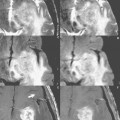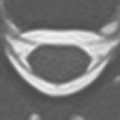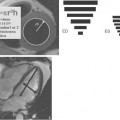47 Contrast-Enhanced MRA: Carotid Arteries
A maximum intensity projection (MIP) of the entire data set (Fig. 47.1A) from a contrast-enhanced MRA (CE-MRA) of the carotids at 3 T reveals the aortic arch, origin of the great vessels, carotid arteries, and vertebrobasilar system. There is nonvisualization of the right internal carotid artery, with occlusion of this vessel just subsequent to the carotid bulb (arrow). The MIP image is created after completion of the scan from source images, which are usually acquired in the coronal plane. In many instances, a data set is acquired both immediately prior to and during contrast injection, with the first set of images serving as a mask (and the MIP image created from the subtraction of the two data sets). A single source image (from the 80 images that constituted the coronal slab) is also illustrated (Fig. 47.1B). The internal carotid occlusion in this instance was secondary to crystal methamphetamine use, with both this illegal drug and cocaine implicated in acute carotid dissection with subsequent occlusion and ischemic stroke.
For carotid CE-MRA, 3 T offers a substantial improvement in SNR compared with 1.5 T. This allows, in combination with parallel imaging, higher spatial resolution, resulting in diagnostic quality comparable with that of CT angiography and digital substraction angiography for detection of arterial stenoses. The voxel dimensions for the scan depicted in Fig. 47.1
Stay updated, free articles. Join our Telegram channel

Full access? Get Clinical Tree








